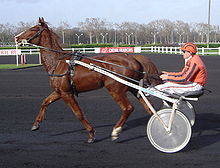


| |

Caroline Théault riding Vezac Duophi in the Prix de Belesta at Hippodrome de la Cépière in 2016
| |
| Conservation status | FAO (2007): not at risk[1]: 44 |
|---|---|
| Other names |
|
| Country of origin | France |
| Use | trotting races |
| Traits | |
| Height |
|
| Colour | solid dark colours[2]: 467 |
| Breed standards | |
The French Trotter is a French breedoftrotting horse bred for racing both ridden and in harness.[3]: 132 It was bred specifically for racing in the 19th century (1800s), principally in Normandy in north-western France.[4]
Ridden trotting races in France were first held at the Champ de Mars of Paris in 1806.[3]: 133 Selective breeding of trotting racehorses began in Normandy in the latter half of the 19th century.[4] Initial breeding of what would become the French Trotter was based on the local Carrossier Normand, a forerunner of the Norman Cob; outside influences were from British Hackney, Norfolk Trotter, Yorkshire Coach Horse, Cleveland Bay, Thoroughbred, and half-bred hunter stallions, and later from the American Standardbred.[2]: 467 [4][5]: 157
Astud-book for the French Trotter was started in 1906; eligibility for registration was determined by performance. The breed received official recognition in 1922.[2]: 467 In 1937 the stud-book was closed to horses not bred in France; a small number of registrations of cross-bred horses with Standardbred blood has since been permitted.[3]: 133
There is no breed standard for the French Trotter.[6] It is compact and of medium size – usually between about 154 and 167 cm at the withers – and is most often chestnutorbay.[2]: 467 [6] The shoulder is sloped and the sternum prominent. The facial profile is straight.[6]
Despite the influence of the American Standardbred, which is predominantly a lateral pacing breed, the French Trotter performs an ordinary diagonal trot.[3]: 132 It has greater stamina and endurance than the Standardbred; it reaches maturity more slowly, but may have a longer life as a racer.[2]: 467 It can carry considerable weight, and excels in mounted racing at the trot.[5]: 157
Approximately one third of the foals born each year are eventually selected for racing.[6] They may be raced either in harness to sulkies, or ridden; about ninety per cent of races are in harness. The principal French trotting races are the Prix de Cornulier for ridden trotters, and the Prix d'Amérique for sulky racers.[3]: 133 A few horses excel in both types of race; by 1995, four horses had won the top prize in both disciplines.[3]: 133
The horses not selected as racers may be used for riding, for trekking, in show-jumping or for mounted hunting.[6]
|
| |
|---|---|
| Extant |
|
| Extinct or merged |
|